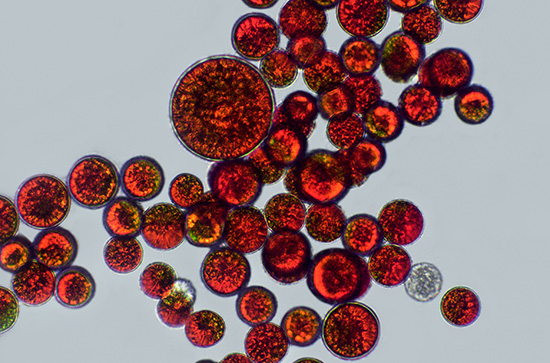Natural red colorant for cosmetics
Astaxanthin from an alga: Haematococcus pluvialis
Have you ever wondered why wild salmon has such a beautiful pink colour? Astaxanthin contained in the Haematococcus pluvialis alga (literally: blood rain alga), the salmon’s main food, is responsible for it. The red colorant is one of the carotenoids which is responsible for many colours found in nature, be it beta carotene that gives carrots their bright orange colour, or lycopene which provides tomatoes and rosehips with their unmistakeable red. But there’s more to it than the colorant property: carotenoids are excellent antioxidants which can significantly increase the value of skin care products.
Astaxanthin – more than a natural colorant for cosmetics
Our concentrate Astaxanthin 5% L (INCI Haematococcus pluvialis extract) serves as a natural red colorant in cosmetics or care products but offers a lot more other advantages as a valued antioxidant. The algae themselves produce Astaxanthin inter alia for protection against UV radiation and it is precisely this effect which can also be used as an active agent in skin care products. The red colorant also supports an even complexion by minimising the melanin synthesis, reduces spots and wrinkles, minimises fine lines and promotes both the metabolism of the skin and its hydration.
Pure algae extract without any preservatives
We gain Astaxanthin 5% L by extraction from the Haematococcus pluvialis alga, or more precisely by super-critical liquid extraction with CO2. As a result of this procedure, we obtain a 100% naturally purified, oily concentrate which we deliver free from any preservatives. The concentrate is oil-soluble, dispersible in water and intended for use in concentrations of 0.1 -1.0 %.
You can find more about the antioxidant, natural colorant Astaxanthin 5% L (INCI Haematococcus Pluvialis Extract).

© Elif Bayraktar - Shutterstock
back


